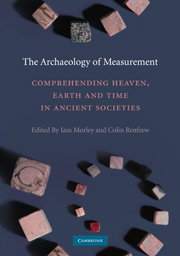Book contents
- Frontmatter
- Contents
- List of figures and tables
- List of contributors
- Acknowledgements
- The Archaeology of Measurement
- Introduction: Measure: Towards the construction of our world
- SECTION I NUMBER: COUNTING, MATHEMATICS AND MEASURE
- SECTION II MATERIALISING THE ECONOMY
- SECTION III DIMENSIONS AND BELIEF
- SECTION IV CALENDAR AND COSMOLOGY
- 14 The measurement of time and distance in the heavens above Mesopotamia, with brief reference made to other ancient astral sciences
- 15 Evolution of the calendar in Shang China
- 16 The measure of time in Mesoamerica: From Teotihuacan to the Maya
- 17 Measuring time, sacred space, and social place in the Inca Empire
- 18 Measuring time in the European Neolithic? The function and meaning of Central European circular enclosures
- SECTION V THE SPIRITUALITY OF MEASURE
- Index
- References
14 - The measurement of time and distance in the heavens above Mesopotamia, with brief reference made to other ancient astral sciences
Published online by Cambridge University Press: 05 June 2012
- Frontmatter
- Contents
- List of figures and tables
- List of contributors
- Acknowledgements
- The Archaeology of Measurement
- Introduction: Measure: Towards the construction of our world
- SECTION I NUMBER: COUNTING, MATHEMATICS AND MEASURE
- SECTION II MATERIALISING THE ECONOMY
- SECTION III DIMENSIONS AND BELIEF
- SECTION IV CALENDAR AND COSMOLOGY
- 14 The measurement of time and distance in the heavens above Mesopotamia, with brief reference made to other ancient astral sciences
- 15 Evolution of the calendar in Shang China
- 16 The measure of time in Mesoamerica: From Teotihuacan to the Maya
- 17 Measuring time, sacred space, and social place in the Inca Empire
- 18 Measuring time in the European Neolithic? The function and meaning of Central European circular enclosures
- SECTION V THE SPIRITUALITY OF MEASURE
- Index
- References
Summary
The evidence concerning mensuration and numeration to be gleaned from clay tablets unearthed in and around Mesopotamia has much to say of profound importance for the history of human cognition, if indeed human cognition has a history and we are not merely tracing the results of individual endeavour. We should, for the sake of the perceived relevance of our disciplines, be prepared to state how our research might permit us to say something about ‘becoming human’, and I will, in particular, in the following react to the supposition of the editors of this volume who, when organizing the symposium from which these chapters are derived, wrote that
the construction of measurement systems implies, in a certain sense, the construction of new means for recognizing and engaging the material world, in a broader sense for cognizing the world. It is in this process that both aspects of spirituality and the more specific conceptions of early religions must emerge.
I will concentrate on the evidence pertaining to the measurement of distances and times in the heavens mainly from Mesopotamian, but also briefly from Greek, Indian, Iranian, and Chinese sources, and the implications thereof for ‘becoming human’. This will be preceded by some comments on the earliest evidence for numeration and measurement in Mesopotamia, matters that concerned the assembled delegates in particular, but first a note of caution must be sounded.
- Type
- Chapter
- Information
- The Archaeology of MeasurementComprehending Heaven, Earth and Time in Ancient Societies, pp. 183 - 194Publisher: Cambridge University PressPrint publication year: 2010
References
- 2
- Cited by



